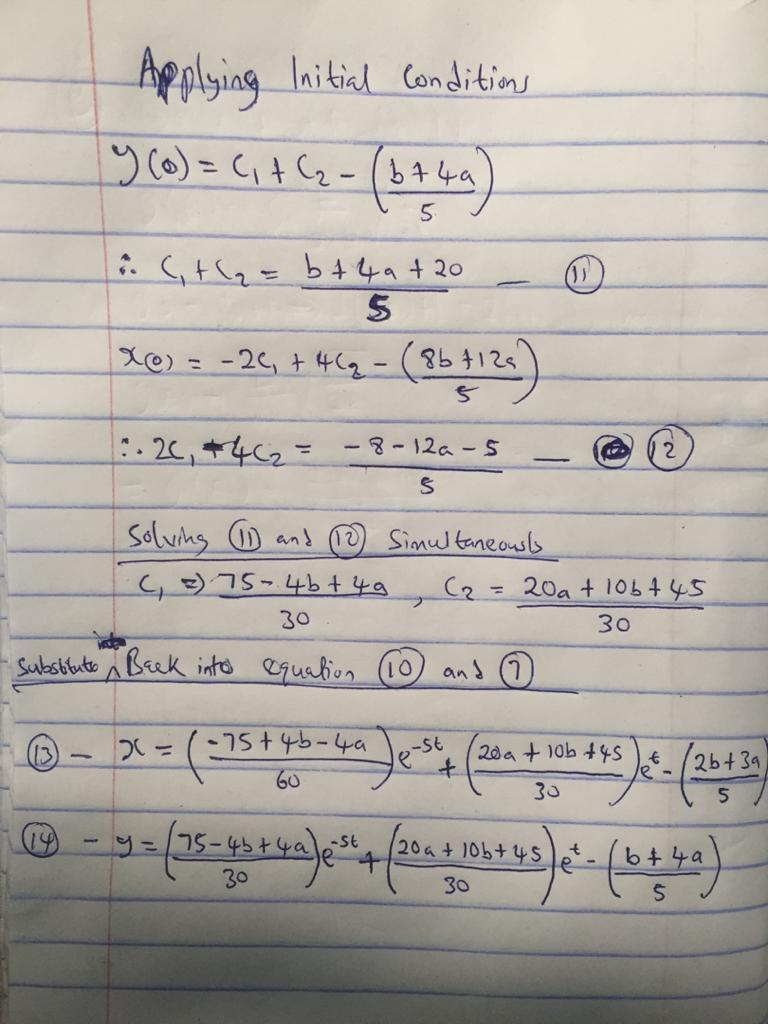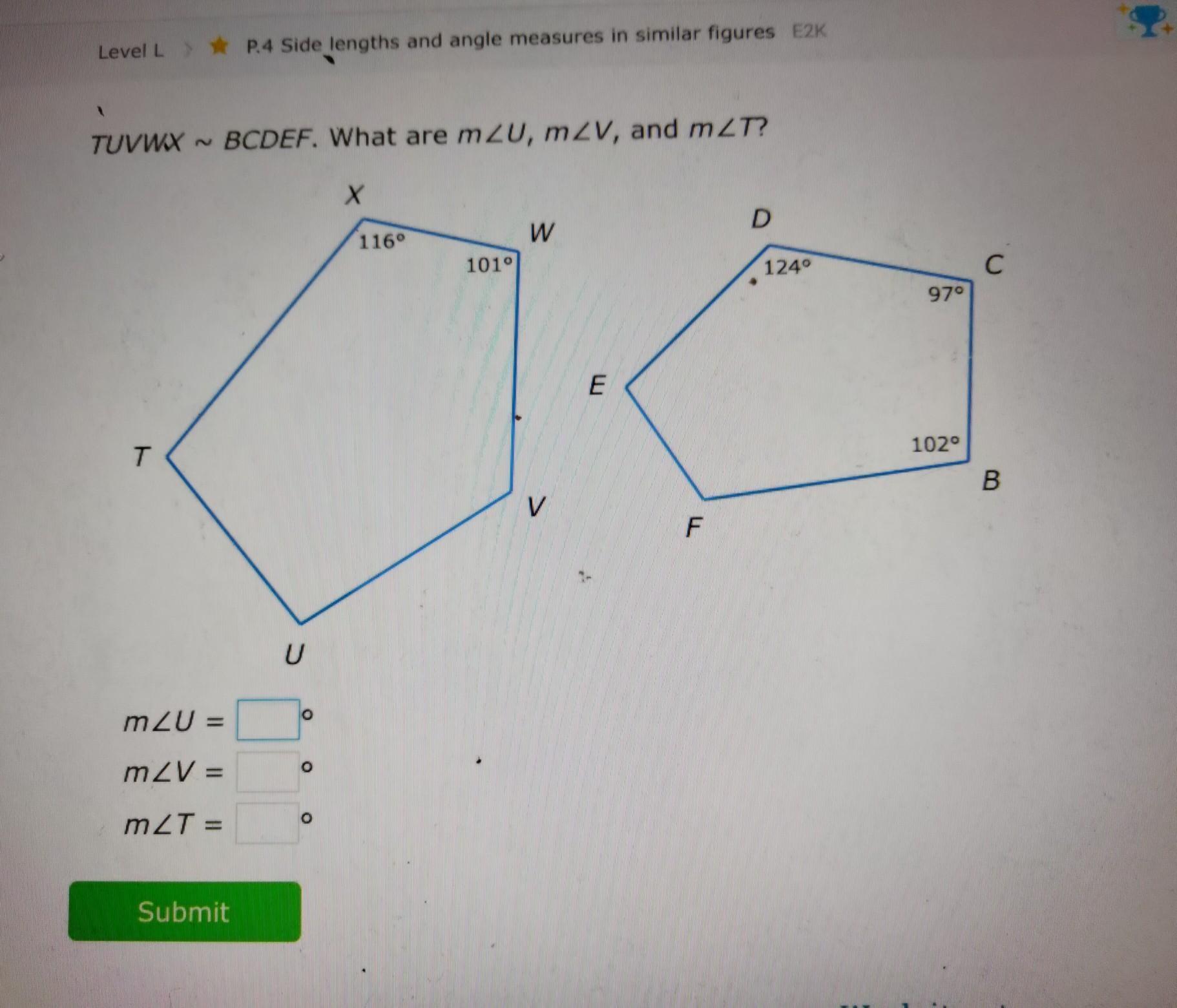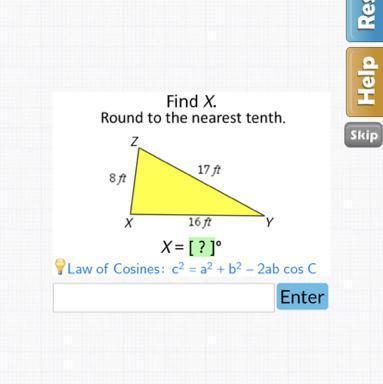Answers
Answer:
nota entonces jwbsbsbwhe de un 2
Related Questions
What’s the units?? Plz need help

Answers
Answer: 4 units
Step-by-step explanation:
need help with math plz thanks

Answers
Answer:
0
Step-by-step explanation:
\(f(x)=2x-4\\f(2)=2(2)-4\\f(2)=4-4\\f(2)=0\)
Answer:
0
Step-by-step explanation:
If f(x) = 2x - 4
Then f(2) = 2(2) -4
f(2) = 4 - 4
= 0
Which number line shows Point A at −4, Point B at 2.5, Point C at −2 and 1 over 2, and point D, which is the opposite of point A?
Answers
Answer:
the answer is D
Step-by-step explanation:
Answer:
Your answer would be D
Step-by-step explanation:
:)
What is the equation for the following table?
Time (hr) 2 4 5 9
Pay ($) 16 32 40 72
Question 5 options:
y=1/8x
y=2x
y=8x
y=16x
PLEASE HELP ILL MARK BRAINLIEST
Answers
Answer:
Y=1/8x
Step-by-step explanation:
To find answers to tables, you simplify the ratios as much as possible.
A trucker wanted to track how long it took to reach Bismarck. When she started out, her clock
read 7:00AM. When she refueled, the clock read 8:00AM. After reaching Bismarck, the clock read
10:00AM. How many hours did it take this trucker to reach Bismarck?
Answers
Answer:
Below
Step-by-step explanation:
From 7 to 10 AM is THREE hours (if the times are all on the same day)
Find each of the numbers below. Simplify your answers as much as possible. The opposite of 0: The opposite of 10: The opposite of the opposite of 1:
Answers
The opposite of a number in the number on the other side of 0 number line and the same distance from zero. For instance,
the opposite of 2 is -2. They both are at the same distance from zero.
In the same way, the opposite of zero is itself.
The opposite of 10 is -10 and
The opposite of 1 is -1.

Given the points (-2, 6) and (0, -7) find the slope.
Answers
Answer:
-13/2
or
-6.5
Step-by-step explanation:
yeah-ya.......... right?
I need help on this please.......

Answers
Answer:r;kf mf
Step-by-step explanation:r;kwmew
Answer:
Your answer is A
Step-by-step explanation:
You have to multiply all the coordinates by 5
Hope this helps
plz mark brainliest
Which is longer 5 meters or 400 millimeters?
a. 400 millimeters
b. 5 meters
c. both a and b are correct.
d. both a and b are incorrect
Answers
Answer:
b. 5 meters
Step-by-step explanation:
1 meter = 1000 millimeters
5 meter = 5000 millimeters
Which is longer 5 meters or 400 millimeters?
5000 > 400
So, the answer is b. 5 meters.
This conversion can be understood by the prefix “milli” in millimeter, as “milli” means 1/1000. So, millimeter means 1/1000 of a meter or 10^-3meters.
So, let’s multiply the conversion by 5 since we want to determine if 5 meters is longer than 400mm.
Conversion, where m=meter and mm=millimeter
1m=1,000mm
Since we have an equal (balanced) relationship, if we increase one quantity by 5 times, we must do the same for the other to maintain equality (balance).
1m•5=1,00mm•5
5m=5,000mm
Therefore, 5m is longer than 400mm since 5m=500mm and 500mm>400mm.
Answer: 5 meters is longer
Arms Race. A simplified mathematical model for anarms race between two countries whose expenditures fordefense are expressed by the variables x1t2 and y1t2 is:___________
Answers
Answer:
hello your question is incomplete attached below is the complete question
answer : The speed of e^-5t is faster and approaches infinity faster than e^t this is because as t → ∞ , e^-5t approaches 0 and e^t remains constant which simply shows that X and Y are constants when t → ∞
Step-by-step explanation:
attached below is a detailed solution of the problem
The speed of e^-5t is faster and approaches infinity faster than e^t this is because as t → ∞ , e^-5t approaches 0 and e^t remains constant which simply shows that X and Y are constants when t → ∞



A sequence can be generated by using an= 3an-1, where a1 = 10 and n is a whole number greater than 1.
What are the first 3 terms in the sequence?
A. 3, 13, 23
B. 10, 30, 90
C. 10, 13, 16
D. 3, 30, 300

Answers
Answer:
B
Step-by-step explanation:
using the recursive rule \(a_{n}\) = 3\(a_{n-1}\) and a₁ = 10, then
a₁ = 10
a₂ = 3a₁ = 3 × 10 = 30
a₃ = 3a₂ = 3 × 30 = 90
the first 3 terms are 10 , 30 , 90
Find the inverse of A = 9, -2 -10, 7 , if it exists.
Answers
The inverse of matrix A, if it exists, is:
A^(-1) = [7/43, 2/43; 10/43, 9/43]
To find the inverse of a matrix A, we need to determine if the matrix is invertible by calculating its determinant. If the determinant is non-zero, then the matrix has an inverse.
Given the matrix A = [9, -2; -10, 7], we can calculate its determinant as follows:
det(A) = (9 * 7) - (-2 * -10)
= 63 - 20
= 43
Since the determinant is non-zero (43 ≠ 0), we can proceed to find the inverse of matrix A.
The formula to calculate the inverse of a 2x2 matrix is:
A^(-1) = (1/det(A)) * [d, -b; -c, a]
Plugging in the values from matrix A and the determinant, we have:
A^(-1) = (1/43) * [7, 2; 10, 9]
Simplifying further, we get:
A^(-1) = [7/43, 2/43; 10/43, 9/43].
For more such questions on Inverse of matrix:
https://brainly.com/question/27924478
#SPJ8
A person wants to order ferns for his garden He checked the price at a nursery and found that the nursery charges 89 for delivery and $5 for each plant ordered He also noted that there are no debvery charges lors
of $70 or more. Based on his findings, he wrote the following functions
f(n) = 9+ Sn to represent the cost of n plants when a delivery charge is included
• g(n) = 5n to represent tt» cost of n plants with no delivery charge
Match the domain to the function
All positive integers All integers greater than or equal to 70 All positive integers less than 70 All integers greater than or equal to 14
All non-negative integers less than 14 All non-negative integers less than 70 All positive integers less than 14
Domain
Function
g(n)
Answers
Answer:All non-negative integers less than 70 for f(n) and All integers greater than or equal to 70
Step-by-step explanation:
It asks about the price before and after the free delivery.I’m not the best at explaining but I hope my answer helped.
The domain of the given functions are required.
The domain of \(f(n)\) is All non-negative integers less than 14.
The domain of \(g(n)\) is All integers greater than or equal to 14.
When the order is less than $70 a delivery charge of $89 is added and each plant costs $5.
The function representing the situation is
\(f(n)=89+5n\)
If the order is or more than $70 then the function will be
\(g(n)=5n\)
The domain of a function is the permissible values of \(n\) for which the function is valid.
In the first function the number of plants that need to be bought so that the order will be 70 dollars would be
\(\dfrac{70}{5}=14\)
So, only if less than 14 plants are bought then the first function can be used.
Also, the number of plants cannot be negative or zero hence it will be positive.
So, the domain of \(f(n)\) is All non-negative integers less than 14.
In the second function the number of plants has to be 14 or more as it costs 70 dollars or more.
So, the domain of \(g(n)\) is All integers greater than or equal to 14.
Learn more:
https://brainly.com/question/17440903
https://brainly.com/question/15099991
The scenes and the graph relate to the reaction of X₂(g) (black) with Y₂(g) ( orange ) to form XY(g).
(a) If reactants and products are in their standard states, what quantity is represented on the graph by x?
(b) Which scene represents point 1? Explain. (c) Which scene represents point 2 ? Explain.

Answers
The point that is marked X on the graph is the standard free energy of the reaction.
What is the standard free energy of the reaction?Let us note that when we talk about the standard free energy of the reaction what we mean here is the energy of the reaction that is free to be able to do work. In the case of the standard change in the free energy, we are looking at the change of the free energy of the standard states of the substance.
The graph as we have it is trying to show the reaction profile and the reaction profile would give the difference between the free energy of the products and the reactants and this is the standard change in free energy.
Learn more about free energy:https://brainly.com/question/15319033
#SPJ1
a pet store has 2 gray rabbits. one eight of the rabbits at the pet store are gray. how many rabbits does the pet store have?
Answers
2 = 1/8
2 x 8 = 16
16 = 8/8
2 gray rabbits is 1/8 of 16. The store has 16 rabbits.
because if 2 rabbits are gray. and is those two = 1 eighth. then two rabbits would equal 1 out of eight. so whats two x eight? 16. it just seems like the logical answer.
HELP PLEASE !!!!!!!!!!!!!!!!!!

Answers
Answer:
?
Step-by-step explanation:
A single die is rolled. Find the odds in favor of rolling a number greater than 2.
The odds in favor of rolling a number greater than 2 are
(Simplify your answers.)
Answers
Answer:
2/3
Step-by-step explanation:
1 and 2 are taken away, therefore you have 3, 4, 5, and 6 left as options to roll. So the answer is 4/6 since there's 4 numbers, but simplified it's 2/3.
Answer:
There are six possible outcomes when rolling a die, each of which is equally likely. Of these six outcomes, three are greater than 2 (3, 4, 5) and three are not (1, 2, 6). Therefore, the odds in favor of rolling a number greater than 2 are 3 to 3, or simply 1 to 1. Alternatively, we could express this as a probability: the probability of rolling a number greater than 2 is 3/6, or 1/2, since there are three favorable outcomes out of a total of six possible outcomes.
Step-by-step explanation:
Find the equation of the line tangent to the curve defined by f(x) = x^2+1 / square root x at the point (1,2). Show all your work.

Answers
Answer:
\(y=x+1\)
Step-by-step explanation:
I am assuming that, given the nature of the curve, you know what a derivative is, and you know how to compute the derivative of the ratio of two functions.
\(f'(x) = \frac1{(\sqrt x)^2}[(2x+0)\sqrt x-(x^2+1)(\frac1{2\sqrt x})]\)
Could be rewritten in a nicer form? Probably, do we care? No, let's just evaluate it for \(x=1\):
\(f'(1)=\frac11 [(2)(1)-(1+1)\frac12]=1[2-1]=1\)
We're almost done. We got the point, we have the slope, we can rewrite the tangent line as
\(y-y_0=f'(x_0)(x-x_0)\\y-2=1(x-1) \rightarrow y=x+1\)
An amount of Birr 500 is deposited in an account at the end of each six-month period with an interest computed at 6% compounded semi-annually. How many years does it take for the amount to reach Birr 56,398.43?
Answers
It would take approximately 17.12 years for the amount to reach Birr 56,398.43 with a deposit of Birr 500 at the end of each six-month period, compounded semi-annually at an interest rate of 6%.
To solve this problem, we can use the formula for compound interest:
A = P(1 + r/n)^(nt)
Where:
A = Final amount
P = Principal amount (initial deposit)
r = Annual interest rate (in decimal form)
n = Number of compounding periods per year
t = Number of years
In this case, the principal amount is Birr 500, the annual interest rate is 6% (or 0.06), and the interest is compounded semi-annually, so there are 2 compounding periods per year.
We need to find the number of years (t) it takes for the amount to reach Birr 56,398.43.
Let's substitute the given values into the formula and solve for t:
56,398.43 = 500(1 + 0.06/2)^(2t)
Divide both sides by 500:
112.79686 = (1 + 0.03)^(2t)
Take the natural logarithm of both sides to eliminate the exponent:
ln(112.79686) = ln(1.03)^(2t)
Using the property of logarithms, we can bring down the exponent:
ln(112.79686) = 2t * ln(1.03)
Now, divide both sides by 2 * ln(1.03):
t = ln(112.79686) / (2 * ln(1.03))
Using a calculator, we find t ≈ 17.12.
For more such question on interest. visit :
https://brainly.com/question/25720319
#SPJ8
MUST HELP!!!! (25 POINTS) +BRAINLEST +5 STARS +THANKS ON PROLFILE!!!!
Lines AA’, BB’, CC’ intersect at the _________
*use one of the words below to fill in the blank*
Equal, 2.4, point of dilation, Scale factor, perimeters, (7.2,4.8), Enlargement areas, (4.8, 9.6)

Answers
Answer:
Enlargement Areas
Step-by-step explanation:
if you enlarge the little one, they will intersect each other perfectly because those triangles are similar and the same. they are just different sizes
hope this helps!
Only two full boxes and a box that was 75% full. Create a written expression
Answers
Answer:
2( 100%) +75%
Step-by-step explanation:
a full box will literally be 100%, so two full boxes will be 2 × a full ie 100%, 'and' a box ie 75% full is addition '+'
Can some one help me ASAP and thanks :)

Answers
Step-by-step explanation:
Hi,
For the first one...
Input: 0 Output: 1
Input: 2 Output: 2
Input: -8 Output: -3
Input: 100 Output: 51
And then for the creat your own...
Divide by 5 and add 3
Input: 50 Output: 13
Input: 25 Output: 8
Input: -75 Output: -12
Input: 150 Output: 33
I hope this helps :)
URGENT!! ILL GIVE
BRAINLIEST!!!! AND 100
POINTS!!!

Answers
Answer:
5^2
Step-by-step explanation:
For example:
a circle has 10 unit of radius, its area is pi10^2 = 314.16
then we dilate the radius by multiply by 5 is 50, pi50^2 = 7853.98
7853.98 ÷ 314.16 = 25
and 25 is equal to 5^2
NO LINKS!!! Please help me with this match

Answers
Step-by-step explanation:
Corresponding angles of similar figures are congruent.
Angles with vertex of same order number are corresponding.
m∠U = m∠C = 97°m∠V = m∠D = 124°m∠T =m∠B = 102°Answer:
m∠U =97°
m∠V = 124°
m∠T = 102°
Step-by-step explanation:
As TUVWX ~ BCDEF then the corresponding interior angles are the same.
Therefore:
m∠T = m∠B = 102°
m∠U = m∠C = 97°
m∠V = m∠D = 124°
m∠W = m∠E = 101°
m∠X = m∠F = 116°
what is y= -5/4x+6 on a graph
I tried mathaway but it's not helping
Answers
Answer:
6.oz and all other things are going on
Step-by-step explanation:
its been a few weeks and I've just got back to
Find X
Round to the nearest tenth.

Answers
Answer:
83 degrees
Step-by-step explanation:
17^2 = 8^2 + 16^2 - 2 * 8 * 16 * cos (X)
289 = 64 + 256 - 16 * 16 * cos(X)
289 = 320 - 256 cos(X)
289-320 = -256 cos(X)
- 31 = -256 cos(X)
31 = 256 cos(X)
31/256 = 256/256 cos(X)
0.121094 = cos (X)
x = arccos 0.121094
x = 83.04475538
in how many ways can a family of four be seated at a round table if two brothers must sit together a)1 b)8 c)2 d)4
Answers
Answer:
8
Step-by-step explanation:
i think this is right if not it would be 2
The Damon family owns a large grape vineyard in western New York along Lake Erie. The grapevines must be sprayed at the beginning of the growing season to protect against various insects and diseases. Two new insecticides have just been marketed: Pernod 5 and Action. To test their effectiveness, three long rows were selected and sprayed with Pernod 5, and three others were sprayed with Action. When the grapes ripened, 400 of the vines treated with Pernod 5 were checked for infestation. Like- wise, a sample of 400 vines sprayed with Action were checked. The results are: EXERCISES Republicans Democrats Number sampled 1,000 800 Number in favor 200 168 Number of Vines Checked Number of Insecticide (sample size) Infested Vines Pernod 5 400 24 Action 400 40 At the .05 significance level, can we conclude that there is a difference in the pro- portion of vines infested using Pernod 5 as opposed to Action
Answers
Answer:
Please find the attached file of the complete question:
Step-by-step explanation:
Given:
\(Pernod \ 5: n_1= 400\\\\ p_1=\frac{29}{400}=0.0725\\\\Action: \ n_2= 400\\\\ p_2=\frac{38}{400}= 0.095\\\\\)
Calculating the value of the test hypothesis:
\(H_{O} \ :p_1-p_2=0\\\\ \ H_{a}:p_1-p_2 \neq 0\)
Let \(a=0.02\) is the critical value \(Z(0.01)= -2.33\)
\(H_0\) rejects when\(z <-2.33 \ \ or\ \ z >2.33 .\)
Calculating the Pooled proportion:
\(= \frac{(29+38)}{(400+400)}\\\\ = \frac{(67)}{(800)} \\\\ = 0.08375\\\\=0.084\)

A town has a population of 2000 and grows at 4% every year write an equation to represent the scenario
Answers
Answer: \(P=2000(1.04)^t\).
Step-by-step explanation:
It is given that,
Initial population of a town = 2000
Growth rate = 4% = 0.04 per year
The exponential growth function for population is
\(P=P_0(1+r)^t\)
where, \(P_0\) is initial population, r is growth rate and t is number of years.
Substitute \(P_0=2000,r=0.04\) in the above equation.
\(P=2000(1+0.04)^t\)
\(P=2000(1.04)^t\)
Therefore, the required equation is \(P=2000(1.04)^t\), where P is population after t years.
Find the area of a rectange with a base of 3/7 feet and a height of 9/10 feet
Answers
The area of the rectangle is 27/70 square feet.
Area of a rectangleThe area of a rectangle is given by the formula:
Area = base x height
Plugging in the given values, we get:
Area = (3/7) x (9/10)
Simplifying, we get:
Area = (27/70) square feet
Therefore, the area of the rectangle is 27/70 square feet.
More on the area of rectangles can be found here: https://brainly.com/question/20693059
#SPJ1
